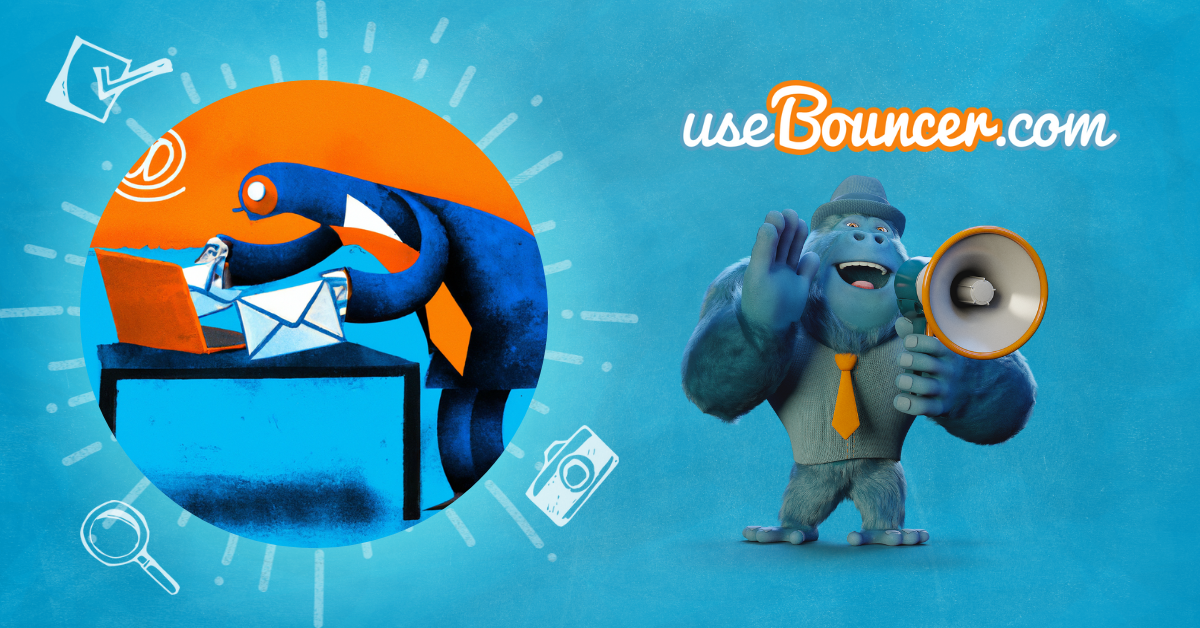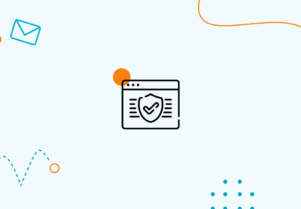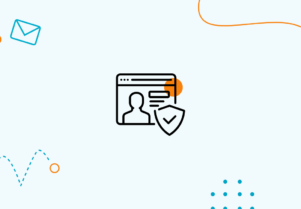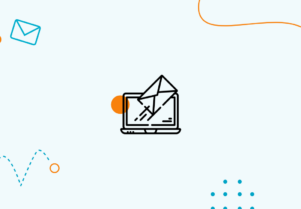The Importance of SOC2 Compliance for Email Verification
Cleaning your email list manually when you “only” have 100 or so email addresses on it can be pretty time-consuming.

But what if you have thousands of addresses to go through? Then vetting out all inactive or incorrect addresses on the list is nearly impossible – unless you use an email list verification tool.
However, you don’t want just any tool – you want to use an email validation tool with SOC2 compliance.
What is SOC2, and how can it protect the information inside your email list? You’ll find everything you need to know about it in our article.
Understanding SOC2 Compliance
Before we get to how SOC2-compliant email providers can guarantee the safety of your email list, we need to know what SOC2 is.
What is the SOC2 standard?
SOC 2 (Systems and Organization Controls 2) is a set of cybersecurity and privacy standards for service organizations. The requirements were developed by the American Institute of Certified Public Accountants (AICPA) in 2010, to specify how service providers should manage, store and protect customer data to minimize security risks and incidents.
Although SOC2 compliance is still “only” a voluntary standard, an increasing number of service providers apply for the security audit – both to protect their service and their customers from breaches.
In an A-lign study, for example, 47% of respondents said that the SOC2 audit was the most important audit for their business.
There are two types of SOC2 audits:
- During Type 1, an independent auditor inspects and analyzes specific business practices and processes to see how well they fit the requirements for the relevant trust principles.
- Type 2 examines the same processes but over a period of time, typically from 6 to 12 months.
What are the five Trust Service Criteria (TSC) for SOC2 compliance framework?
The SOC2 framework is made out of five Trust Services Criteria (TSC), namely:
- Security
- Availability
- Confidentiality
- Processing Integrity
- Privacy
Security (also called Common Criteria) is mandatory for all companies that want to go through the SOC2 audit. The rest are optional, so businesses can only apply for audit categories that matter to them.
At Bouncer, for example, we included service availability and data confidentiality in our audit.
Let’s now take a closer look at trust service principles.
Security (Common Criteria)
Security audits examine the level of security and compliance across the entire organization:
- Security procedures and policies
- Protection against unauthorized access or data misuse
- User access settings
- Implemented security features (firewall, encryption, multi-factor authentication, etc.)
- Company procedures for security incidents or breaches, etc.
The actual list of audit requirements is far longer, though. During a typical security audit, a SOC2 auditor evaluates 80-100 security controls to cover all places where an incident might happen.
You can find a detailed list of the security requirements on the AICPA website.
Availability
The second category in the SOC2 audit is Availability, meaning examining the service’s uptime and performance. The auditor will also check:
- What disaster recovery practices the organization has in place
- How often they create backups
- What methods do they use to monitor service performance and quality
- Whether they have processes for handling security incidents
Confidentiality
During a confidentiality audit, SOC2 auditors will inspect how service organizations store customer data (especially sensitive and confidential types of data) and how well it is protected.
Companies that store information protected by Non-Disclosure Agreements (NDAs) or whose clients require that their data be erased after their contract ends often include this category in their audit as well.
Processing Integrity
The processing integrity audit checks whether the data added and processed inside the organization’s system is reliable and free of errors. The auditor will also look at how the information inside the system is processed – for example, what part of it is lost or corrupted during processing.
They will also measure how long it takes for the processed data to be ready for use and how a given company resolves any processing issues.
Privacy
During this part, a SOC2 auditor will analyze how PII (Personally identifiable information) is gathered, stored, and protected from breaches or misuse.
Privacy criteria might seem identical to Confidentiality ones, but there’s one significant difference though. Namely, while confidentiality requirements are related to all types of sensitive materials a business might store, Privacy applies only to PII information (such as birthdates or social security numbers).
Benefits of being SOC2 compliant
Running such a thorough security audit in an organization might seem like a lot of work and time spent on this activity. A SOC 2 Type 1 report usually takes about two months, while a SOC 2 Type 2 report can take from 6 to 12 months.
However, the benefits of having a SOC2-certified service more than make up for the time and effort needed.
Here are three main reasons why running a SOC 2 audit can benefit companies in the long run.
Enhanced protection
One of the biggest benefits of a SOC2 audit is that it can help companies strengthen their security protection measures. By running a security audit, they can find their strong and weak points when it comes to security and pinpoint places with the highest risk of a security incident happening.
Then, using the knowledge from the audit, they can plan and implement the security practices that will help them solve their main cyber security issues in the company.
That way, organizations can gain the confidence that they have sound data protection and security policies in place so they can better handle security breaches.
Improved regulatory compliance with local and international laws
An extra benefit of going through and passing a SOC2 audit is that their requirements often overlap with other important security standards.
So by running a SOC2 audit first, organizations can make it easier for themself to become compliant with:
- Health Insurance Portability and Accountability Act (HIPAA) and The Health Information Technology for Economic and Clinical Health (HITECH)
- International Organization for Standardization (ISO) 27001
- Payment Card Industry (PCI) Data Security Standards (DSS) or other PCI regulations
- International privacy standards such as Europe’s GDPR or California’s CCPA.
For businesses aiming to become both SOC2 compliant and, for example, HIPAA compliant, the AICPA has also created a few guides on how these requirements overlap.
Increased customer trust
With how many headlines they see about database breaches, it’s no wonder that customers are getting increasingly concerned about the safety of their data.
By displaying a SOC2 audit badge, a company can reassure its customers that they have already taken steps to strengthen its service security and protect the data inside its systems. And by seeing that a service provider has passed a SOC2 audit, the customers (especially those handling sensitive materials) can feel more at ease using a given service.
The Role of SOC2 Compliance in Email Verification
To get the most out of your email list, it’s essential that you regularly remove invalid and inactive emails from the list – why send your newsletter or offers to someone who won’t even open the mail?
As we already mentioned in the intro though, cleaning the email list manually is not exactly an option when you have several thousand names on the list. Here’s where email verification tools such as Bouncer come in handy, as they can handle most of the heavy lifting connected to verifying the addresses on the list.
That said though, how can you find a reliable email verification service that won’t make a mess out of your list? And most importantly, that will also keep your email list fully secure.
Using a verification service that is SOC2 compliant is the answer. Why? Here are a couple of reasons.
Protecting sensitive email data
By working with a SOC2-compliant verification service provider, you can be sure that they know how to take good care of sensitive information inside your email lists and the emails themselves.
For example, all emails that go through Bouncer are automatically hashed, and the customer details in our databases are encrypted as well.
Reducing the risk of data breaches
SOC2 audit checks whether the service providers have the industry security practices in place and know how to handle unexpected situations. That way, the risk of a breach (either through an employee mistake or through a cyber attack) is minimized. Without this, you’ll be at risk of common cybersecurity threats like credit card theft, phishing and identity theft.
Maintaining data integrity during the verification process
When using a list verification tool, you want to get a cleaned list with verified emails to which you can send your emails straight away. But definitely not a list with corrupted or missing addresses which you need to clean yourself as well.
SOC2-compliant service providers can guarantee that such things won’t happen, as their service was already scanned for similar issues. So you can be sure that the tool will save your time (and nerves as well), rather than waste it.
Getting accurate and consistent verification results
Another thing the SOC2 audit is verifying is how reliable the service is, and how well it can work under load. So when using a SOC2-compliant service, you can be sure you’ll get accurate results, no matter how large your list is or how many people are using the service at the moment.
Demonstrating commitment to data security
What is a better way to prove to a customer that a service provider is treating cybersecurity seriously than by showing a SOC2 compliance badge on their website?
By passing the audit, service providers can prove that they both know how to safeguard the data inside their systems from harm and also that they have all the right tools and procedures in place to protect their infrastructure from cyber attacks.
Enhancing customer trust and credibility
Having the SOC2 audit report available to read for all visitors is a great way to answer some of the availability or security-related questions the visitors might have.
For example, if they worry about a potential service downtime or require a specific email encryption service, the information inside the audit report should put their mind at ease. And when they see they can rely on the service provider to keep their data safe, they are also more likely to trust the providers with their own email lists.
Meeting customer expectations
With how many cyberattacks there are every day and how severe the consequences might be, customers now expect that businesses will treat cybersecurity and data protection as their top priority.
That’s why a growing number of companies searching for business services ask first whether the service provider is SOC2-compliant before they decide to purchase the service – to make sure their business data is entirely safe.
One report, for example, found that 33% of the companies surveyed said that customers ask about SOC 2 certificates while researching how a given company secures its data.
In that way, having the SOC2 badge and the audit report on your website can give you an edge over your competitors.
Bouncer: A SOC2 Compliant Email Verification Tool
For us at Bouncer, ensuring that the data passed through our service is as secure as possible is a priority. So we are happy to say that since February 2023, we are now SOC2 Type 1 compliant (Type 2 is in progress!).
Our service was tested by SOC2 auditors for:
- Data and infrastructure security,
- Service availability
- Confidentiality.
Based on the audit results, we then outlined and implemented several security measures, thanks to which we have built fortress-level security inside our platform.
How Bouncer meets the requirements of SOC2 compliance
So what exactly did we do to make our email verification service more reliable, resilient, and secure?
Regular security audits and assessments
At least once a year, we perform:
- A risk assessment audit
- A penetration test (performed by a third-party company)
- A review of our Access Control Policy and Organization chart.
Once a quarter meanwhile, we have a vulnerability scan for our production environment.
Security measures implemented by Bouncer
We have also enhanced how the data is used and stored inside our company by:
- Using a version control system to manage source code, documentation, and other important materials.
- Having an outlined process both for employees and customers for reporting security, confidentiality, integrity, and availability incidents and concerns to the management.
- Creating an incident response plan and assigning dedicated employees to the response team.
We also use the Drata platform to monitor the company’s policies, procedures, and IT infrastructure to ensure that our employees adhere to industry standards.
Encryption
The entirety of data in our platform (both stored on physical devices and on the cloud) is encrypted through SSL/TLS encryption. In addition, the information inside all company-issued laptops is also automatically encrypted via Full disk encryption.
Access control and monitoring
- We are using the “least privilege policy” for customer data, meaning that employees can only access the customer details they need for their work tasks
- To access or add changes to the version control system, employees must have admin permission
- To access sensitive data and applications, we require a two-factor authentication in the form of a user ID, password, OTP, and/or certificate.
That’s only a fraction of the work we did to ensure our platform is fully secure, though.
To learn more about what security practices we have implemented after the audit (and what we do to make sure we keep our fortress-level security), you can read the full Security Report created by Drata that’s available on our website.
The impact of SOC2 compliance on Bouncer’s performance and reliability
The hard work was more than worth it though. Thanks to the SOC2 audit, we could learn far more about our service and infrastructure security and find places where we could make our email verification service even better.
So in that way, the audit helped us to:
- Better protect our email verification service from cyber threats
- Ensure a high-quality and reliable service for all our customers
- Reassure our business partners that their data is safe in our hands
Have you been searching for a list verification tool that has an outstanding accurate rate but also robust data protection measures in place? Bouncer is ready to help – whether you have thousands or millions of addresses, you can get a fresh and active email list in no time.
And if you want to test out how Bouncer works first, you can verify your first email addresses entirely for free 🙂
So how about checking out for yourself how clean your list can be, with our help?
Make sure you choose a SOC2 Compliance friendly tool
Email verification tools can be a fantastic help for your business. Just give them a list of email addresses you have, and they will highlight all addresses that might never open your emails. So why should you spend your time and money on them?
To make sure that you (and your employees) will be the only people using the list though, you should look for email verification services with top-notch security. And a SOC2 compliance badge, like the one you can see on our Bouncer page, is exactly a sign of such security.
With the app on your side, the entire heavy lifting of cleaning your list can be done for you – and once the new list is ready, you send your newsletters or offers straight away.
SOC2 Compliance Frequently asked questions
What is SOC2 compliance and why is it important for service providers?
SOC2 is a security standard set by the American Institute of Certified Public Accountants (AICPA) that measures a service company’s ability to protect the privacy, security, and confidentiality of customer data.
Going through a SOC2 audit, service providers can learn more about how they can keep sensitive information safe from data breaches or unauthorized access and how they can strengthen their internal security.
How does SOC2 compliance benefit service providers and their customers?
By passing a SOC2 audit, service organizations demonstrate that they know how they can protect business data and their service from breaches, misuse, and cyberattacks. That can put their customers more at ease, especially those that require a high level of security from the cloud services they are using.
How can SOC2 audit benefit email verification services?
Email verification providers handle plenty of sensitive information, such as email addresses and customers’ personal data. By going through the SOC2 audit, they can find out how well is the data protected inside their network and what can they improve to make their services more resilient.





